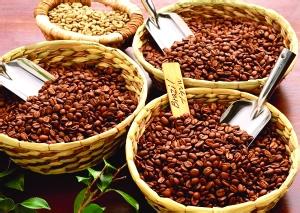The process of making coffee from coffee trees to crushing-how to grow coffee trees in famine and shipwreck
The process of making coffee from coffee trees to crushing-how to grow coffee trees in famine and shipwreck
From harvest to delivery
After the fruit is harvested, the skin and flesh must be removed. The endocarp and silver peel are removed to form coffee beans. There are two kinds of methods: drying (natural drying, non-washing) and washing.
Dry type, the operation is relatively simple, the harvested fruit will be spread on the dry ground and basked in the sun for a week or two. The sound of rattling can be heard when it is turned, which means it is dry. Then use the sheller to remove the pulp, endocarp and silver skin of the dried fruit.
This method gives coffee beans a soft sour taste and a mild bitter taste. This method is used in Brazil, Ethiopia, Yemen and other places. Disadvantages: vulnerable to weather, defective beans and foreign bodies are more likely to mix. Therefore, it is necessary to select it carefully before delivery.
In the washing type, the harvested fruit is poured into the sink, the floating matter is removed, the fruit in the water is moved to the pulp removal machine, the skin and pulp are removed, and then put back into the tank to remove the floating matter, the "core" in the water is poured into the fermentation tank, soaked for half a day or one day, the colloid on the surface of the fermented bean is removed, washed, dried or mechanically dried, and the endocarp is removed on the peeling machine to become commercial raw coffee beans.
The advantages of washing type: coffee beans have good luster, less foreign bodies, and slightly better sour taste. Colombia, Mexico, Guatemala and other countries have adopted this method. Coffee beans produced by washing account for almost 70% of the total output of coffee beans.
Sometimes poor treatment of fermentation time will produce fermentation odor and special sour taste; if handled well, it can form the personalized aroma of coffee beans.
At this time, the coffee beans can be sent to various places in sacks or in special containers.
Immature coffee is actually green, after 6-7 months of maturity, the mature skin is red, because its shape and color are similar to cherries, so foreigners call mature coffee a cherry (Cherry). Under the bright red skin, it is a sweet sticky yellow substance that covers the whole coffee bean. Under normal circumstances, each coffee bean actually has two coffee beans, flat opposite, the general situation of coffee beans has a very thin diaphragm tissue ─ silver skin (SilverSkin), each coffee bean and its silver skin are located in a hard milky bean-shaped shell with protective dyeing, called Parchment, which separates coffee beans from mucus.
Normal coffee trees sometimes grow some smaller ones, but there is only one hole in the tree. Coffee beans, which have different names, are called round beans (Peaberry), or single beans. They do not have a flat side. On the contrary, they are smaller and almost round. Because it is very small, and it must be specially selected and gathered together, therefore, its price is much higher than that of general coffee beans, and many people feel that the taste of round beans is particularly good, because its round bean shape can put the original taste of coffee tightly in the beans, and the taste is particularly strong. Many coffee lovers regard it as the best of coffee beans.

Important Notice :
前街咖啡 FrontStreet Coffee has moved to new addredd:
FrontStreet Coffee Address: 315,Donghua East Road,GuangZhou
Tel:020 38364473
- Prev

How to set the shutdown time manual of the Ecokey on the Delong coffee machine
If you are using a Delong coffee machine, it is recommended not to use coffee powder, because if you can not add more than 2 tablespoons of coffee powder at a time, it will damage the machine. In addition, adding only one spoonful of coffee powder at a time is too slow for the unit to make coffee; in addition, the taste of coffee powder is not as good as coffee.
- Next

Cleaning instructions for Merlot Coffee Machine 960
Melaleuca Coffee Machine 960 cleaning instructions 1. This Merlot coffee machine can adjust the height of the coffee outlet, up to 135mm. Two. Merlot's new machine has three functions of adjustable coffee concentration. Three. Removable water tank 1.2 with automatic detection of water level function, in order to better avoid water shortage. 4. The machine is equipped with CLARIS water purification filter element, which can
Related
- What documents do you need to go through to open a coffee shop? coffee shop coffee shop certificate processing process
- How to purchase Coffee beans in small Cafe how to choose a suitable supplier for domestic Coffee supply Company
- How to drink Starbucks Fragrance White Coffee? how to make Australian White Coffee? what Italian coffee beans are recommended?
- The Story of Flora Coffee: the name of Flora Coffee Bean and the implication of the Flowers on Florna Coffee
- How much does a cup of coffee cost? How much is the profit of a cup of coffee? What is the profit of the coffee shop in a year?
- Yunnan small Coffee, known as "fragrant Coffee", introduces the characteristics of Alpine Arabica Coffee producing areas in Yunnan, China
- 2023 latest Starbucks full menu price list how much is a cup of Starbucks coffee what is better to drink the most popular hot and cold drinks recommended
- Starbucks different kinds of Coffee Price list Starbucks menu 2023 Top Ten Best drinks in Starbucks
- Starbucks Spring praise Comprehensive matching Coffee Bean theme Story Packaging implication and taste description
- The cost of a cup of coffee latte American coffee cost price and selling price

